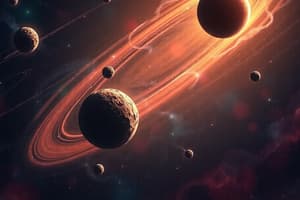Podcast
Questions and Answers
What volatile materials are comets primarily made up of?
What volatile materials are comets primarily made up of?
- Water, ammonia, and methane (correct)
- Oxygen and argon
- Carbon dioxide and nitrogen
- Helium and hydrogen
Why do comets create a glowing coma and a long tail when they approach the Sun?
Why do comets create a glowing coma and a long tail when they approach the Sun?
- Because of their dense metallic core
- Due to their solid rock composition
- From absorbing solar radiation
- As a result of evaporating volatile materials (correct)
How do comets' tails typically behave in relation to the Sun?
How do comets' tails typically behave in relation to the Sun?
- They are not affected by the Sun's gravity
- They always remain stationary
- They always point directly towards the Sun
- They can point away from the Sun due to solar wind (correct)
According to the solar nebula hypothesis, what formed the icy bodies that became comets?
According to the solar nebula hypothesis, what formed the icy bodies that became comets?
Which region is believed to be the birthplace of most comets in our solar system?
Which region is believed to be the birthplace of most comets in our solar system?
How is the formation process of comets related to that of asteroids and other small solar system bodies?
How is the formation process of comets related to that of asteroids and other small solar system bodies?
What is the main difference between asteroids and comets in terms of composition?
What is the main difference between asteroids and comets in terms of composition?
Where do comets originate from?
Where do comets originate from?
What causes the visible coma and tail of a comet when it approaches the Sun?
What causes the visible coma and tail of a comet when it approaches the Sun?
Which space mission returned comet dust samples to Earth?
Which space mission returned comet dust samples to Earth?
What is the primary reason bright comets are relatively rare?
What is the primary reason bright comets are relatively rare?
When was Halley's Comet discovered?
When was Halley's Comet discovered?
Flashcards are hidden until you start studying
Study Notes
Formation of Comets
Comets are icy bodies that originate from the outermost edge of our solar system, the Oort Cloud, which is a vast, spherical shell of icy bodies and cosmic debris surrounding the Sun. Comets are made up of volatile materials such as water, ammonia, and methane, which evaporate when they approach the Sun, creating a glowing coma, or atmosphere, and a long, glowing tail. These tails can point away from the Sun due to the solar wind.
Formation Process
Comets are believed to be remnants from the early solar system, formed when the Sun and its planets were still in the process of formation. The formation process of comets is closely related to the formation of asteroids and other small solar system bodies. According to the solar nebula hypothesis, the solar system developed out of a huge cloud of gases and dust floating through space, which gradually collapsed under gravity to form the Sun and the planets. The material that did not form planets was left over, and this material eventually formed the icy bodies that we now call comets.
Oort Cloud and Kuiper Belt
The Oort Cloud and Kuiper Belt are two important regions in the outer solar system that are believed to be the birthplaces of most comets. The Kuiper Belt is a region of icy bodies and cosmic debris located beyond Neptune's orbit, while the Oort Cloud is a much larger, more distant region that extends far beyond the Kuiper Belt. Comets in the Oort Cloud have very long orbital periods, some taking more than 200 years to complete one orbit around the Sun.
Visible Comets
Bright comets, which can be seen with the naked eye, are relatively rare. On average, only one bright comet appears per decade. The most famous comet is Halley's Comet, which was discovered in 1682 and is known for its regular appearances every 76 years. Another well-known comet is Comet Shoemaker-Levy 9, which broke apart and crashed into Jupiter in 1994.
Asteroids vs. Comets
Although asteroids and comets share some similarities in their formation and composition, there are key differences between the two. Asteroids are generally made of rock and metal, while comets are composed of ices and other volatile materials. Asteroids are typically found in the inner solar system, while comets come from the outer solar system.
Exploration of Comets
NASA and other space agencies have sent numerous missions to study comets, including Giotto, which passed close to Halley's Comet in 1986, Deep Space 1, which flew by comet Borrelly in 2001, and Stardust, which obtained high-resolution images and returned comet dust samples from Comet Wild 2. Upcoming missions include the European Space Agency's Rosetta mission, which will go into orbit around comet Churyumov-Gerasimenko in 2014.
In conclusion, comets are icy bodies that originated from the outermost edge of our solar system and are believed to be leftovers from the early solar system formation process. They are formed in the Oort Cloud and Kuiper Belt and are made up of volatile materials that evaporate when they approach the Sun, creating a visible coma and tail. Exploration of comets has provided valuable insights into the early solar system and our origins.
Studying That Suits You
Use AI to generate personalized quizzes and flashcards to suit your learning preferences.




